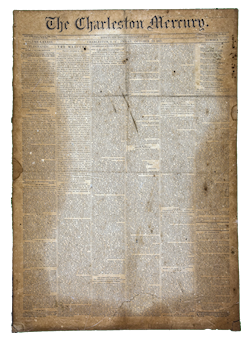June 15, 1863, The Charleston Mercury
The Richmond papers bring us accounts of the great cavalry fight in Culpeper County, Va., last Tuesday, but no two of them agree as to the precise result. All, however, seem to concur in the opinion that our forces were surprised, that the fight was protracted and bloody, and that although victory finally perched upon our banners, it was dearly bought.
The Richmond Sentinel gives the following details of the action:
The cavalry of the enemy numbered, it is supposed eight to ten thousand. It was accompanied and supported by two or three thousand dismounted men and artillery. The enemy’s force crossed in one place, it is said, at a ford prepared by them for the occasion. They thus eluded our pickets, got in their rear and captured them, and pressed on rapidly to our camps. This was at an early hour in the morning. The 1st South Carolina and 4th Virginia, which were on picket, lost many men captured in these early operations. The enemy’s column next fell on General Jones’ brigade, which they found in the act of forming, with guns and pistols not yet loaded. Taking them at this disadvantage, they pierced and broke our line, and forced our men to fall back. They gained so much ground as to capture General Stuart’s headquarters, near Brandy; also, Brandy Station, and, we understand, some stores there. Our men, recovering from their surprise, now rapidly came forward and threw themselves, sabre in hand, upon the enemy. These were driven, in their turn, nearer to the river, with the loss of a number of prisoners, besides the killed and wounded.
The fight fluctuated throughout the day, lasting from five to five – twelve long hours. It was, doubtless, the severest and most extensive cavalry fight of the war. The scene lay chiefly on the farm owned by the late John S. Barbour, Senior. The enemy made much use of their sharpshooters, who, from the shelter of the adjacent timber, did us considerable damage. But the hand-to-hand encounters of cavalry and the crossing of sabres were the principal features of the fight. Many of our own wounded bear the evidence of this on their persons; while the slain and wounded of the enemy prove it still more conspicuously. Our men being caught with unloaded fire arms, left them, indeed, no other resource at first. During the conflict the enemy charged and captured our horse artillery. But it was quickly recaptured by the desperate determination of our troops. – We learn that we amply retaliated afterwards by capturing and holding a battery of four or five guns belonging to the enemy.
The battle at last settled decisively in our favor. The enemy, repulsed and driven at all points, fell back to the Rappahannock and recrossed it. We captured from them in the fight and on the retreat 302 prisoners, already received in this city. Besides these, between fifty and sixty more were brought to Culpeper Court House yesterday morning, and they were still coming. Our own loss is variously stated. The information at the Provost’s office at Culpeper Court House, yesterday morning, was that about two hundred of our men were prisoners. Our killed and wounded are supposed to reach several hundred. Some put the figures higher and some lower. The loss of the enemy in killed and wounded is believed to be considerably greater than ours. This is usually the case with the army that is defeated. The forces engaged on our side were the brigades of Generals Hampton, W. H. F. Lee, and Jones. The fight, on the whole, may be said to have begun in a surprise, and ended in a victory.
